Valencia is an underrated destination. Cities like Barcelona, Madrid, and San Sebastian get more love but in our opinion, Valencia deserves just as much attention. It’s a beautiful city with perfect weather, great architecture, and best of all, amazing food.
Valencia is the birthplace of paella, one of the most celebrated dishes in Spanish cuisine. Eating paella is at the top of many people’s minds when they visit Spain. We’ve enjoyed it in every city we’ve been to thus far but what better place to have it than in the very city that invented this iconic dish?
We travel for food so it wasn’t enough for us to eat paella just anywhere in Valencia. We needed to find the best, so we scoured the internet and asked locals for their opinions on which restaurants served the most delicious paella in Valencia. This is what we found.
PAELLA IN VALENCIA QUICK LINKS
To help you plan your trip to Valencia, we’ve compiled links to top-rated hotels, tours, and other travel-related services here.
HOTELS
Recommended hotels and apartments in Ciutat Vella (Old Town), one of the best areas to stay for first-time visitors to Valencia.
- Luxury: Caro Hotel
- Midrange: Catalina Suites
- Budget: The River Hostel
TOURS
- Sightseeing Tour: Complete Tuk-Tuk Tour Around the City
- Food Tour: Daytime Tapas-Tasting Tour w/ Central Market Visit
- Paella Cooking Class: Paella Workshop, Tapas and Ruzafa Market Visit
- Day Trip: Montanejos Thermal Springs & Waterfall Day Trip
OTHER SERVICES
Save This on Pinterest!
No time to read this guide on the best paella in Valencia? Click on the save button and pin it for later!
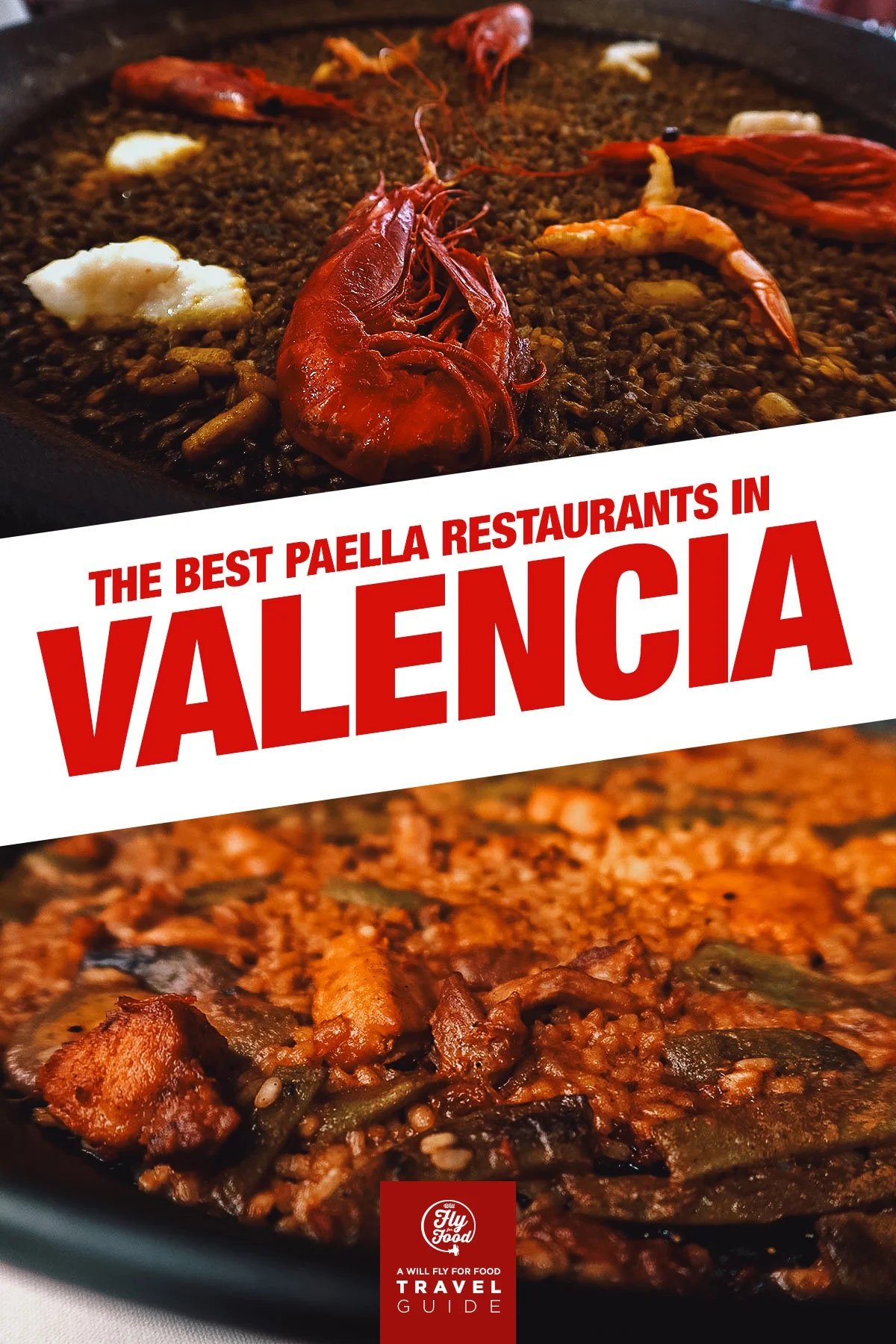
WHAT IS PAELLA?
Paella is a Spanish rice dish made with short-grain rice, extra virgin olive oil, saffron, paprika, salt, and water. These are the classic ingredients used in every authentic paella recipe. Depending on the type of paella being made (which we’ll get to in a bit), other ingredients like meat, seafood, beans, and vegetables are also used.
Paella is cooked in a large flat pan called a paellera. This pan is essential for the preparation of a good paella because it facilitates the evaporation of liquid and allows for the formation of socarrat – the thin layer of caramelized crispy rice at the bottom.
WHERE IS THE ORIGIN OF PAELLA?
You can enjoy paella in every part of Spain but this emblematic dish has its roots in Valencia, specifically in the rice fields of the Albufera – a freshwater lagoon situated around 11 km (6.8 miles) south of central Valencia. It started off as a lunchtime dish prepared by laborers working in the rice fields.
Farm workers would gather what was available to them around the rice fields – vegetables, tomatoes, onions, snails, water vole meat, etc – and then cook them in a paella pan with rice over an orange wood fire. Over time, recipes evolved to include more ingredients like rabbit, duck, chicken, artichokes, and seafood.
It was interesting to learn that the word paella means “frying pan” in the Valencian language. It originally referred to just the pan. The dish became so popular that for the first time in 1840, a Spanish newspaper used the word “paella” to describe the dish and not the pan. The name stuck and the dish has been known as paella ever since.
TYPES OF PAELLA
This is where things get a little dicey. Like many people, I used to think that any Spanish rice dish cooked in a paellera qualified as a paella but apparently, that isn’t the case! Spanish people, especially Valencians, take paella very seriously and assert that authentic paella can only be made with specific ingredients.
Based on what I’ve learned, there are just two (maybe three) Spanish rice dishes that qualify as true paellas.
Paella Valenciana
The quintessential Valencia paella. For a paella to be considered a true paella valenciana, it can only be made with the following ingredients – short-grain rice, rabbit, chicken, butter beans, runner beans, great northern beans, tomatoes, saffron, sweet paprika, fresh rosemary, olive oil, salt, and water.
Duck, snails, and garlic are optional ingredients while artichokes can be used as a substitute for green beans in winter.
Paella de Marisco
Meaning “seafood paella”, paella de marisco is a type of paella developed by Valencian fishermen on the Mediterranean coast. Instead of meat and beans, they used fresh seafood.
Depending on the restaurant in Valencia, you’ll find many versions of seafood paella made with different ingredients – paella with lobster, paella with cod and vegetables, paella with monkfish, paella with carabineros (scarlet shrimp), and more.
Hands down, the most interesting seafood paella we saw was a version made with striped prawns and marine plankton. It turned the rice into an eye-catching shade of Hulk green!
Paella Mixta
This last paella is debatable. Also referred to as preparacion barroca (baroque presentation), paella mixta or “mixed paella” refers to a type of paella made with both land proteins and seafood.
Paella mixta is a point of contention because some Valencians don’t seem to consider it a true paella. To purists, only paella valenciana and paella de marisco are the only versions that can carry the “paella” label.
OTHER POPULAR RICE DISHES IN VALENCIA
You can make a Spanish rice dish with any ingredient you like (even chorizo!), but if itsn’t prepared in the traditional way using the accepted list of ingredients, then you can’t call it a paella. In Valencia, they’ll refer to these dishes as “arroz (something)”.
Here are some of the popular non-paella rice dishes you’ll find at restaurants in Valencia.
Arroz Nergro
As it turns out, what’s long been my favorite paella dish may not be a true paella after all. Known to many people as paella negra (black paella), this dish is more commonly referred to as arroz negro in Valencia. It’s similar to paella de marisco except it’s made with cuttlefish or squid ink that turns everything – including your teeth – into the tastiest shade of black.
Arroz con Verduras
This one was confusing. A Spanish rice dish made with just vegetables, some restaurants listed this as paella de verduras while others called it arroz con verduras. I guess it all depends on how strict you are with the definition of paella.
Fideua
Fideua is a popular dish that’s cooked in a paellera, though it isn’t a rice dish at all. Instead of short-grain rice, it’s made with thin pasta noodles.
Like paella, fideua can be made with different ingredients like seafood, vegetables, and squid ink.
Arròs a Banda
We love learning about new food when we travel and this was one of the dishes that made our trip to Valencia truly special.
Meaning “rice on the side” or “plenty of rice” in Valencian, arròs a banda refers to a dish made with rice cooked in fish stock. It was originally a poor man’s dish that was developed by fishermen from Alicante.
After selling off the day’s best catch, the fishermen would be left with the little bony fish that no one wanted to buy. They’d take the fish home and cook them in a simple stew with potatoes and onions. Not wanting to waste anything, the leftover stock would then be saved and used to cook a rice dish, hence the birth of arròs a banda.
Arroz del Senyoret
We got a kick out of this dish’s name. It refers to a version of seafood paella where all the seafood has already been peeled to make it easier to eat. Senyoret means “little lord” or “gentleman”.
This is another of those confusing tweener paella dishes. Does paella de marisco no longer become a “paella” just because the seafood has already been peeled? Again, it all boils down to strictness of definition.
Arroz Caldoso / Arroz Meloso
Arroz caldoso was another dish that caught our eye in Valencia. Meaning “soupy rice”, it refers to a paella-like dish that’s cooked and served in a deeper pan or pot with a soupy broth. Like other rice dishes in Valencia, it can be made with different ingredients like meat, poultry, seafood, beans, vegetables, and wild mushrooms.
From what I understand, arroz meloso is a similar dish with a creamier risotto-like consistency, somewhere between a soupy arroz caldoso and a drier paella.
Arroz al Horno
Arroz al horno means “baked rice” and refers to a paella-like dish that’s baked in an oven instead of cooking over a live fire. Instead of a paellera, it’s cooked in a shallow earthenware pot called a cazuela that doesn’t facilitate the development of socarrat.
Like paella or fideua, arroz al horno can be made with different ingredients. The simplest recipes call for just rice, tomatoes, chickpeas, garlic, and olive oil but heartier versions can be made with the inclusion of more substantial ingredients like pork, morcilla, and chorizo.
WHERE TO EAT PAELLA IN VALENCIA
With the exception of Menjars la Barraca (#6), every paella restaurant featured in this list offers most if not all the rice dishes described above. They serve delicious paellas all around though some places are better known for a specific type of paella. I’ve made sure to mention which paella to order in those cases.
Keep in mind that rice dishes in Valencia and Spain require a minimum of two portions so if you’re a solo traveler, then you’ll need to consume a two-person order for yourself. Paella is typically served only for lunch in Spain so some of these restaurants are open only during the day.
The best restaurants will make your paella from scratch so it’s a good idea to make advanced reservations whenever you can. Otherwise, be prepared to wait around 40-50 minutes for your paella.
1. Levante (Best Traditional Paella Valenciana)
Being in the birthplace of this iconic dish, eating paella valenciana was at the top of our to-do list. We wanted to find the best place for traditional paella valenciana in the city center and our research led us to Restaurante Levante, a highly-regarded paella restaurant near Bioparc.
According to one of the most reputable food tour companies in Spain, Restaurante Levante is “hailed by locals as the home of the best paella in Valencia”. They may be right!
Pictured below is the paella valenciana senyoret, meaning it’s a version of paella valenciana served with deboned chicken and rabbit. We would have been happy with the traditional paella valenciana but on their English menu, it was described as having “only meat”. I think that may have been a poor translation but we didn’t want to take any chances.
Served with green beans, this senyoret version was delicious and much easier to eat, thanks to the deboned rabbit meat!
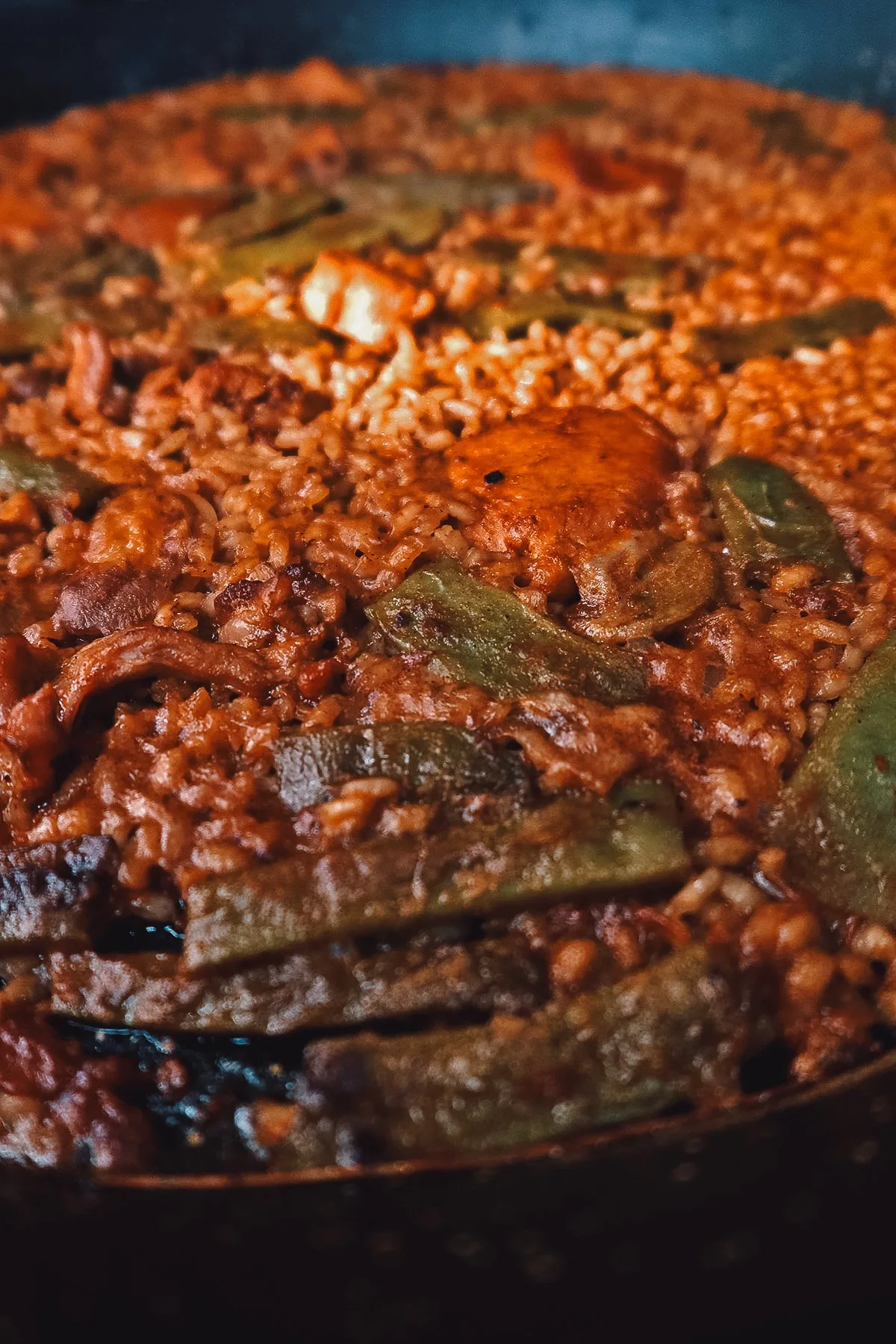
Paella in Valencia is amazing but it isn’t the healthiest dish, so you may want to pair it with ensalada valenciana – a traditional salad made with lettuce and a mix of ingredients like tuna, hard-boiled egg, white asparagus, tomatoes, onions, carrots, cucumber, and olives.
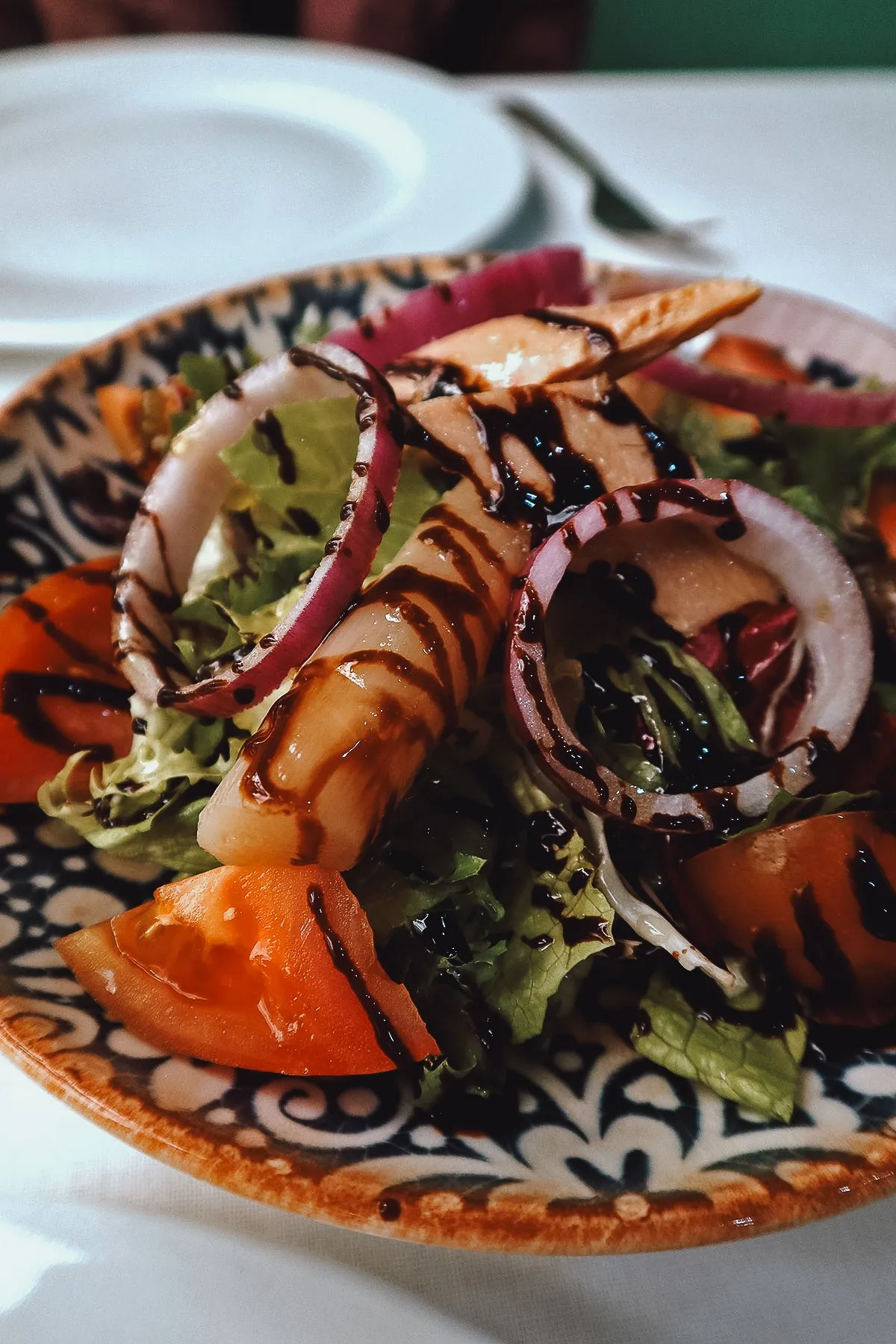
For authentic Valencian paella, Restaurante Levante has a reputation for serving some of the best in the city. If you’re going to Bioparc, then it’s a great restaurant to enjoy a meal before or after visiting the park.

Levante
Address: Av. de Manuel de Falla, 12, Campanar, 46015 València, Valencia, Spain
Operating Hours: 1:30-4PM, daily
2. La Riua
If you’d prefer to go somewhere more centrally-located, then walk over to La Riua, a highly-rated paella restaurant in the Old Town. This popular restaurant already had a queue of people before opening at 2PM but thankfully, we had reservations.
La Riua offers a wealth of rice dishes but we went with their tasty fideua vegetariana. They offer vegetarian paella as well.
If you like the flavors of paella but find the rice too filling, then fideua is a great alternative. Mrs Traveleater actually prefers this over paella.

La Riua offers a few daily specials and this pata de pulpo or grilled octopus leg was one of them. This was absolutely delicious and served as a great protein to pair with our vegetarian fideua.

La Riua is located about a 5-10 minute walk from the Central Market so it shouldn’t be hard to find. As advised, reservations are a good idea.
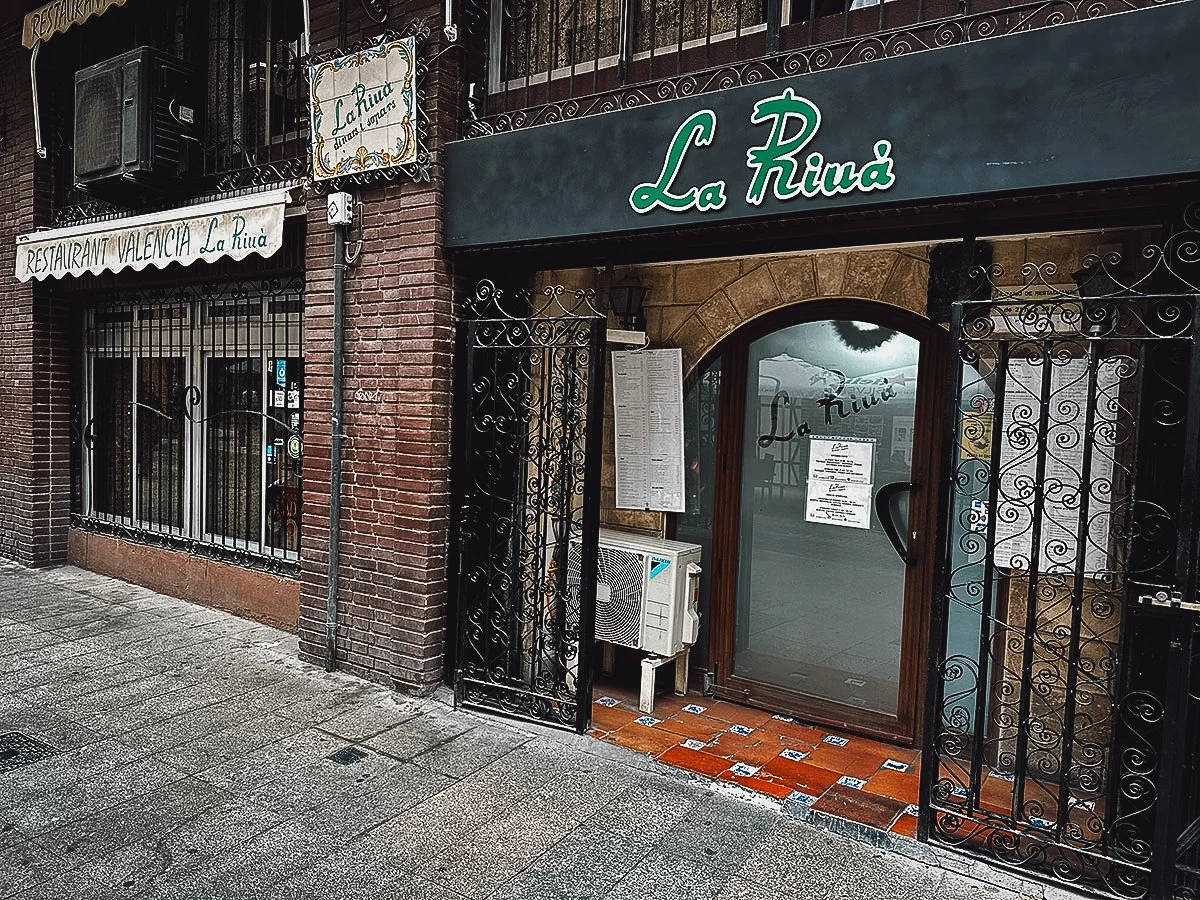
I love La Riua’s traditional interior. It’s a good-sized restaurant with about three levels of seating but it is popular and does fill up quickly.
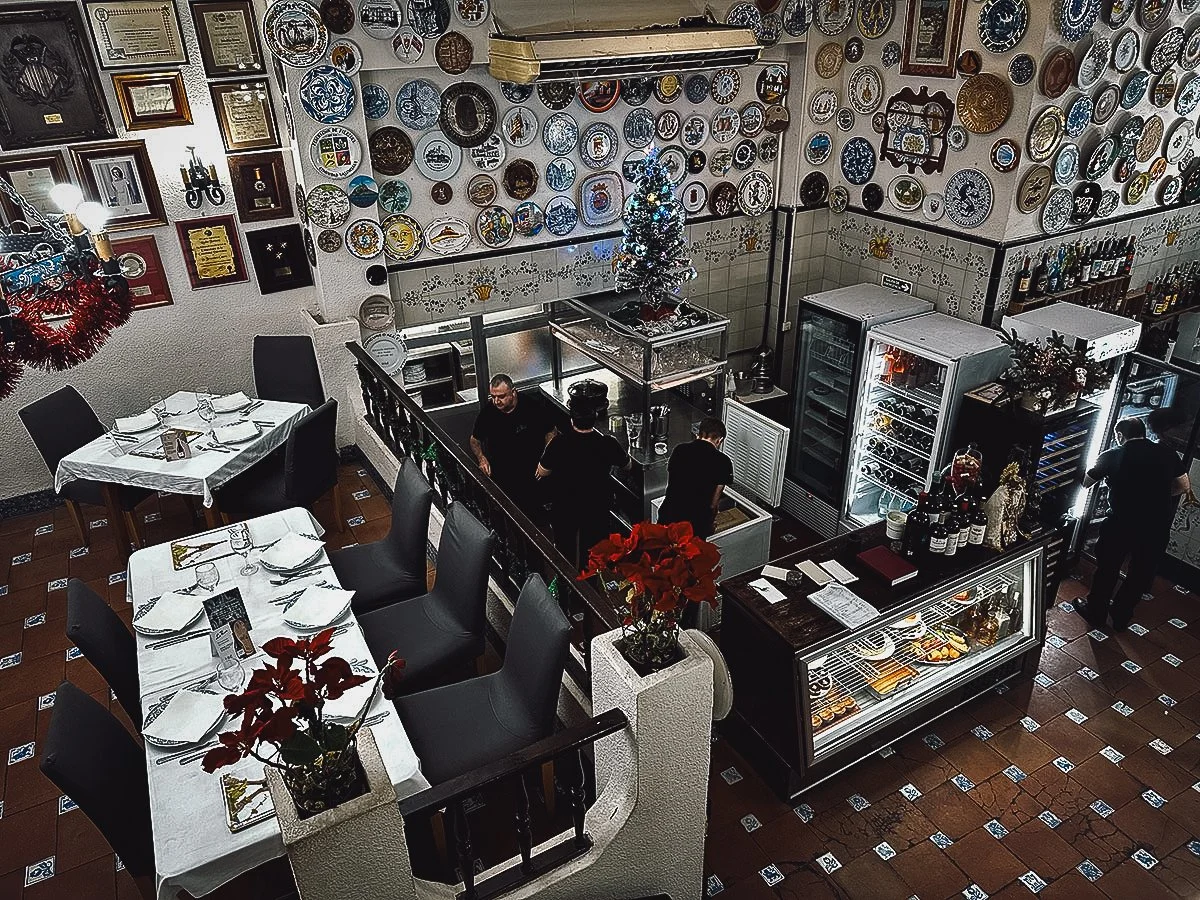
La Riua
Address: C. del Mar, 27, Ciutat Vella, 46003 València, Valencia, Spain
Operating Hours: 2-4:15PM, 9-11PM, Tue, Thurs-Sat / 2-4:15PM, Wed, Sun (closed Mondays)
3. La Pepica
Open since 1898, La Pepica is one of the oldest and most famous paella restaurants in Valencia. Over the decades, many famous people have dined here, including Spanish painter Joaquin Sorolla, former Queen of Spain Sofia, and celebrated American novelist Ernest Hemingway.
Hemingway was said to have come to La Pepica so often that he’d occasionally be spotted helping out in the kitchen. “Dinner at Pepica’s was wonderful… the seafood and the Valencian rice dishes were the best on the beach” he would later write in his novel The Dangerous Summer.
Located along Malvarrosa Beach, La Pepica specializes in paella de marisco. They offer several variations of seafood paella but we went with their paella pepica which is a “senyoret” version served with all the seafood already peeled.

As the story goes, this version of seafood paella was first prepared for Joaquin Sorolla and his artist friends. The owner of La Pepica made this version with peeled seafood to keep them from getting their hands dirty. I guess this is where the senyoret version of paella was invented?
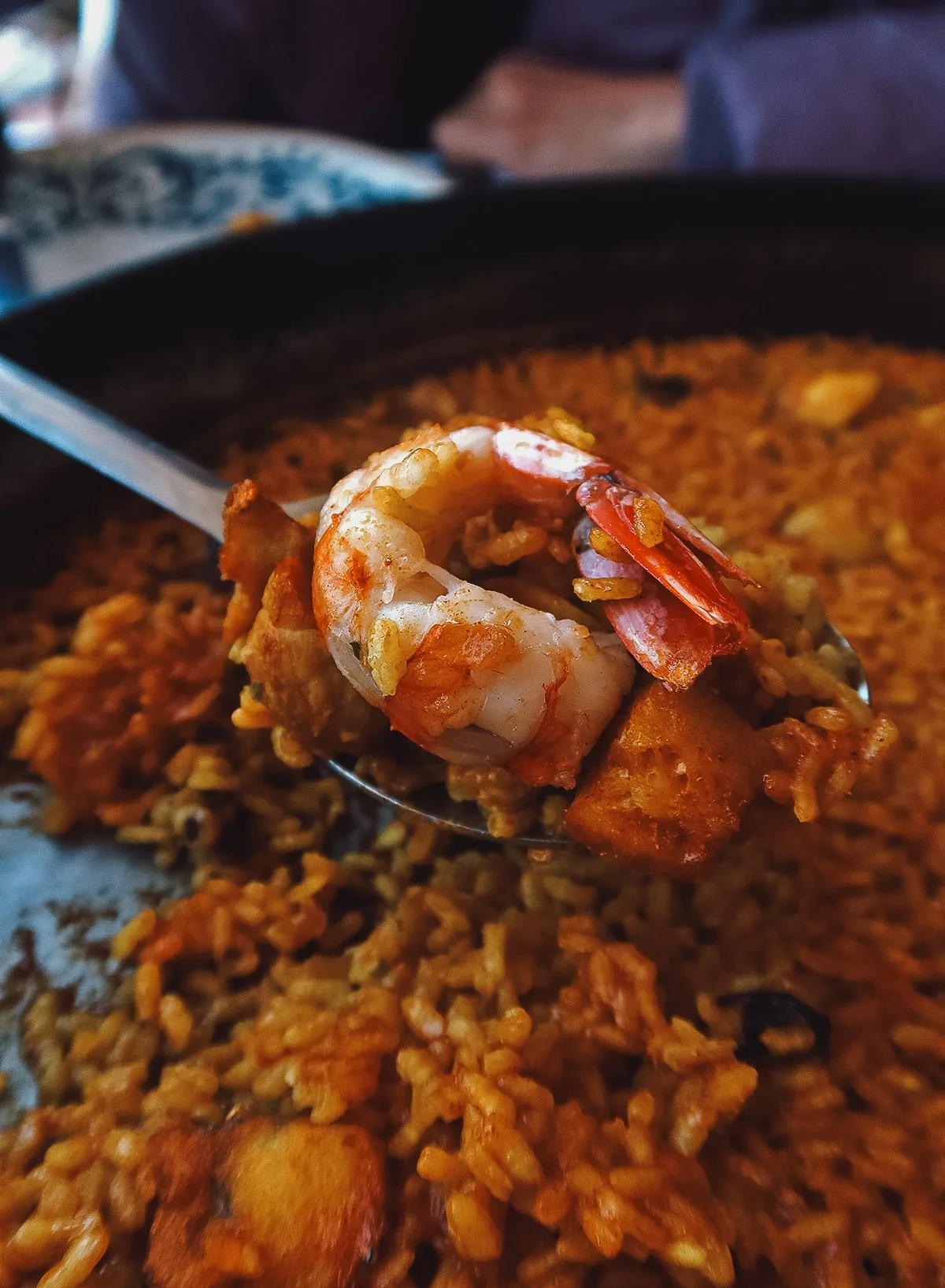
A trusty side of ensalada valenciana to help all that fat go down.

We were in Valencia over the holidays and La Pepica was the only restaurant we could find that was open on New Year’s Day. It’s a huge restaurant with indoor and outdoor seating but the place filled up quickly. Being one of the few paella restaurants that open for New Year’s, I guess this is tradition here every year.
Walking through this large lively dining room, you could just feel the history in this place.

We sat here on their outdoor terrace facing the beach. If you go on an important holiday like New Year’s Day, then reservations are a must.
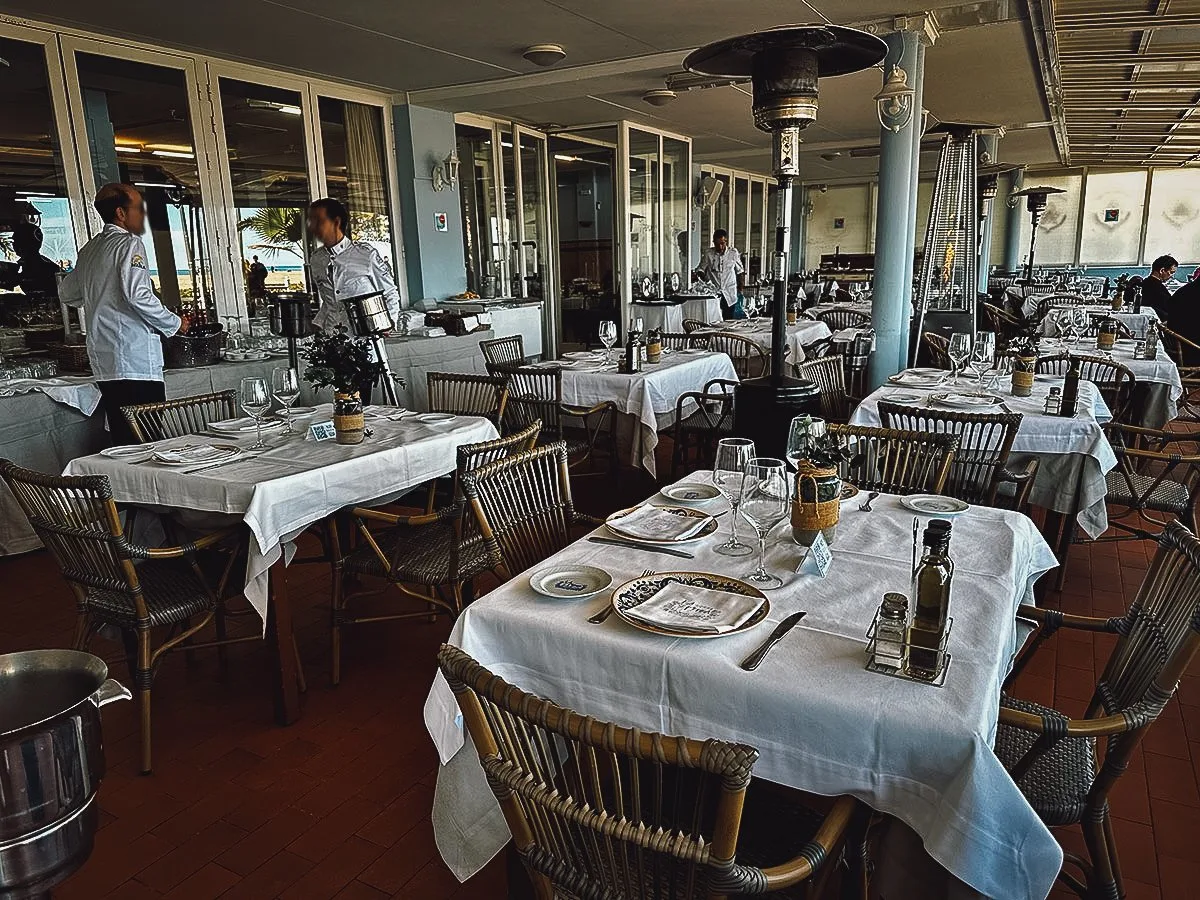
While the majority of paella restaurants in Valencia have modernized and use gas or electric stoves, La Pepica still cooks their paellas the traditional way – over a live wood fire. According to the restaurant’s owner:
“This is the tradition of the house. There is something special about live fire. It can’t be explained, but there’s nothing better than a paella cooked over a wood fire. It gives the rice a different aroma and taste.”
Watching the chefs cook paella after paella in this way was nothing short of mesmerizing.

La Pepica
Address: Passeig de Neptú, 6, BAJO;DUP 6-8, Poblados Marítimos, 46011 Valencia, Spain
Operating Hours: 1-11PM, daily
4. Arroceria Maribel (Amazing Seafood Paella)
There’s no shortage of amazing paella restaurants in central Valencia, but if you want to go the extra mile for truly authentic paella, then we highly recommend taking a bus down to the actual birthplace of paella – La Albufera.
Located about 11 km (6.8 miles) south of central Valencia, the small towns around La Albufera have become a hotbed for some of the best paella restaurants in Valencia, including Arroceria Maribel which has the distinction of being a Michelin Bib Gourmand awardee.
To this point, we’d enjoyed many delicious paellas in Valencia but we wanted something truly special here so we went with this unbelievably delicious paella de rojos or seafood paella served with carabineros, the prized scarlet prawns from Spain.
I had tried carabineros once before, at a tapas bar in Barcelona, but never in a paella like this. Renowned for their large size and deep red color, even when uncooked, they taste sweeter than regular shrimp and are almost lobster-like in flavor and texture. They’re so damn delicious!

Here’s another dish that curious eaters may want to try at Arroceria Maribel. Called all i pebre, it refers to a local specialty made with eel and potatoes that was also born on the banks of the Albufera.

And of course, a heaping house salad to wash all the paella goodness down.
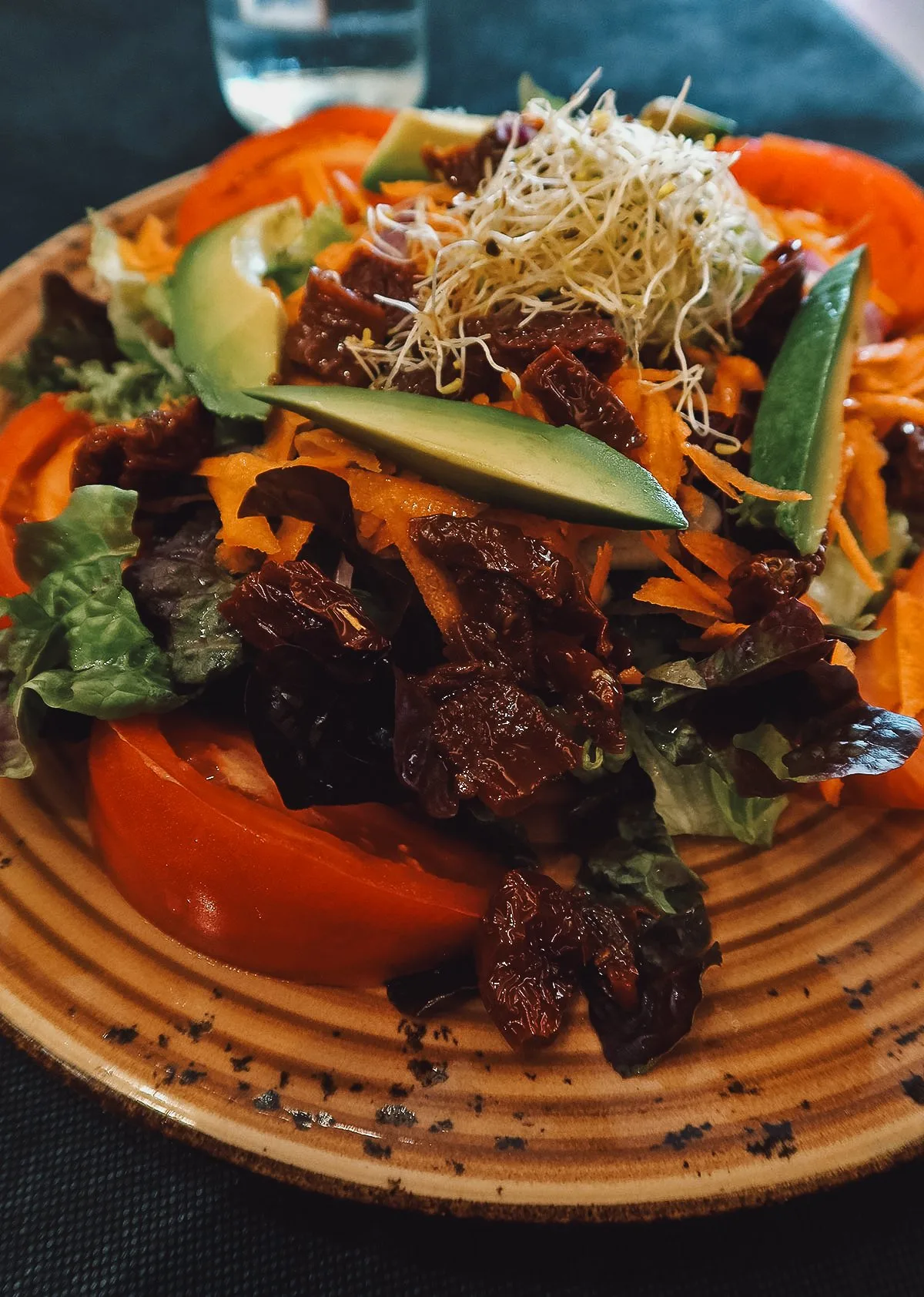
Arroceria Maribel is located in the tiny town of EL Palmar. There are a few restaurants here but this is one of the most popular. If you’re serious about finding the best paella in Valencia, then you need to make a trip to the Albufera.
You can use Google Maps to learn which bus(es) to take to El Palmar from wherever you are in central Valencia. If you don’t have a Valencia Tourist Card, then a single bus ticket costs EUR 1.50 per ride (January 2024). You can take Uber as well but the fare will be much higher, at least EUR 30 each way if I remember correctly.
PRO TIP: There’s only one bus back to central Valencia per hour. These return buses get super crowded so I suggest waiting at the bus stop at least half an hour before the scheduled departure time.

Arroceria Maribel
Address: Carrer de Francisco Monleón, 5, Poblados del Sur, 46012 El Palmar, Valencia, Spain
Operating Hours: 10:30AM-5:30PM, Thurs-Tue (closed Wednesdays)
5. Alqueria del Pou
This restaurant was a real treat. Not only did it introduce us to the deliciousness of arròs a banda, but it gave us a farm-to-dining experience that we didn’t realize was possible in the heart of downtown Valencia. More on that in a bit.
We found Alqueria del Pou when we did a Google search for the best arròs a banda in Valencia. As described, it’s a supremely flavorful Valencian dish that consists of rice cooked in fish stock.
Originally, I read that arròs a banda wasn’t made with any other ingredients, just rice, but today, it can be made with some fish and bits of seafood that are cooked with the rice or served on the side. This seems to explain the dish’s name which means “plenty of rice” or “rice on the side”.

At Alqueria del Pou, they served us the pan with rice first. We thought that was the entire dish, which was fine by us because that rice was unbelievably delicious. Even better than paella!
Minutes later, this pan with the most beautifully cooked seafood and potatoes arrived at our table. Rice on the side indeed!
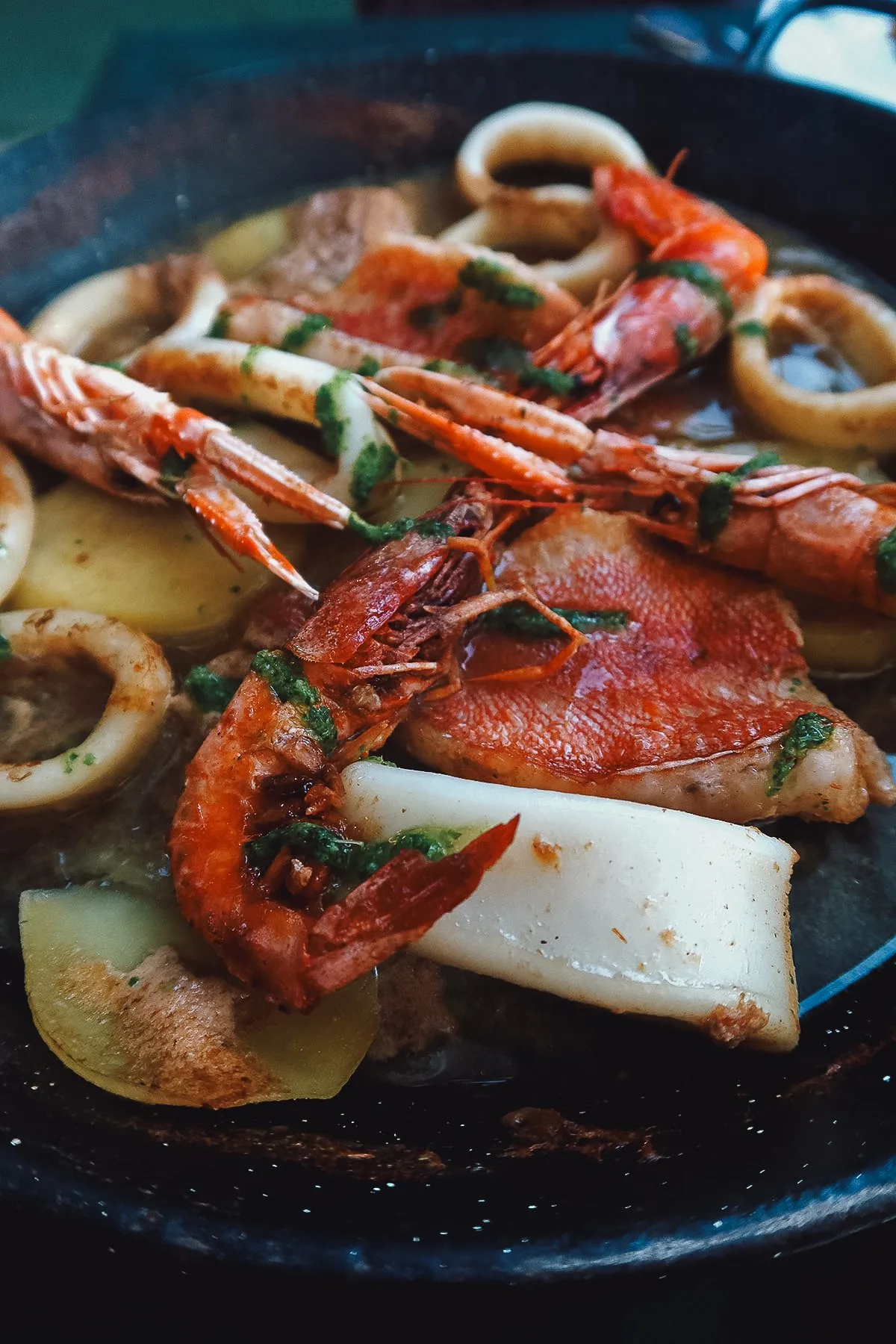
But as good as all that seafood was, the true star of arròs a banda really is the rice. We couldn’t get enough of this it was so delicious. For the love of all things tasty, DO NOT miss this!
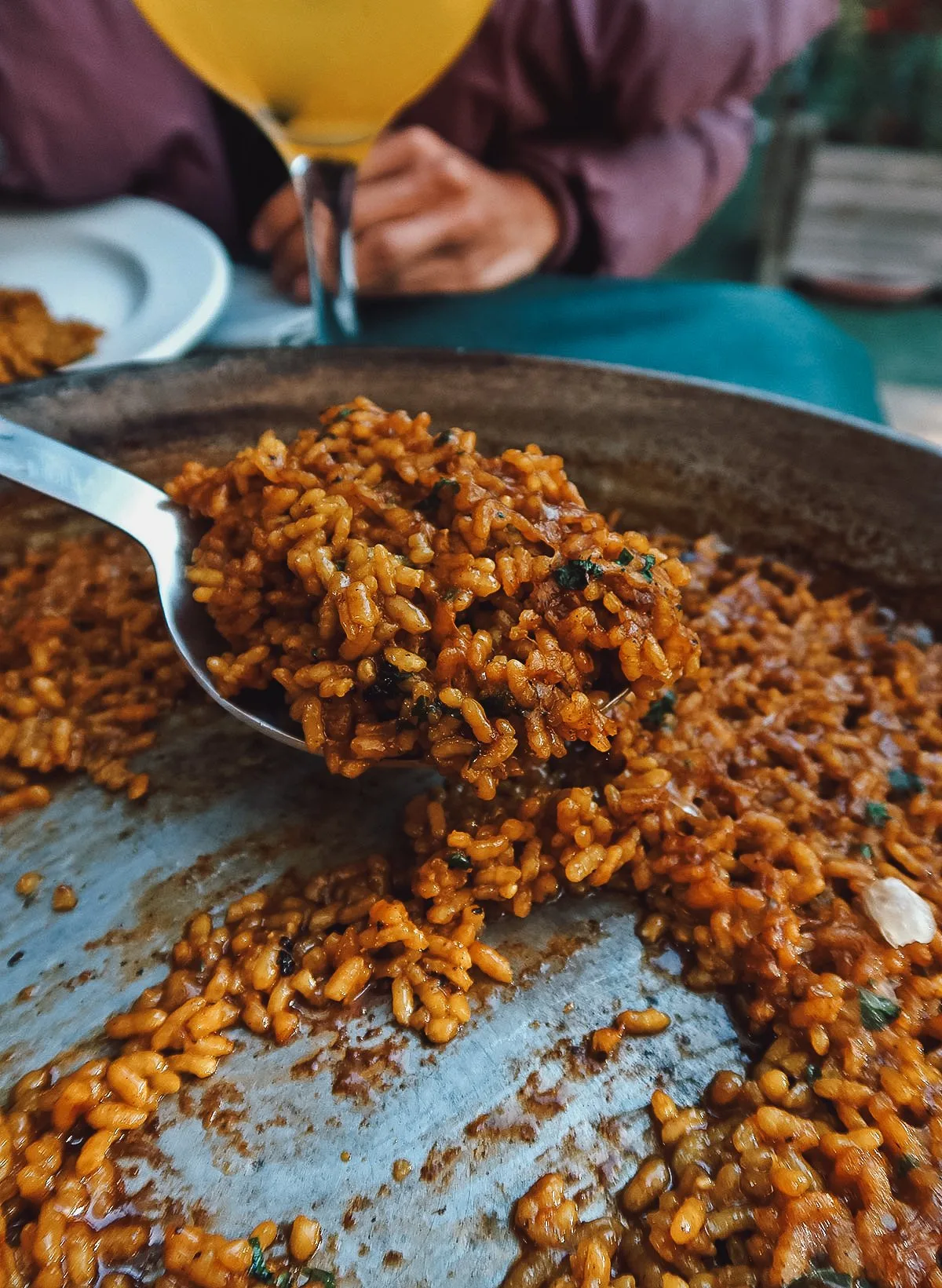
We were in Valencia during the winter season so that meant artichokes were in season. As you’ll soon see, these roasted artichokes couldn’t be any fresher.

What better way to wash down a Valencian dish than with a Valencian drink? Known as Agua de Valencia, this refreshing cocktail is made from cava or champagne mixed with orange juice, vodka, and gin. ¡Salud!

I don’t know if they do this everyday but after our meal, our servers were kind enough to offer us these slices of sponge cake with shots of digestif. ¡Muchisimas gracias and again, salud!

Aside from their delicious food, what makes a meal at Alqueria del Pou so memorable is the restaurant itself. It’s basically a paella restaurant on a farm right in the heart of central Valencia!
This rural-looking space is located just minutes away on foot from the city’s most popular tourist attraction – Ciudad de las Artes y Ciencias. How cool is that?!
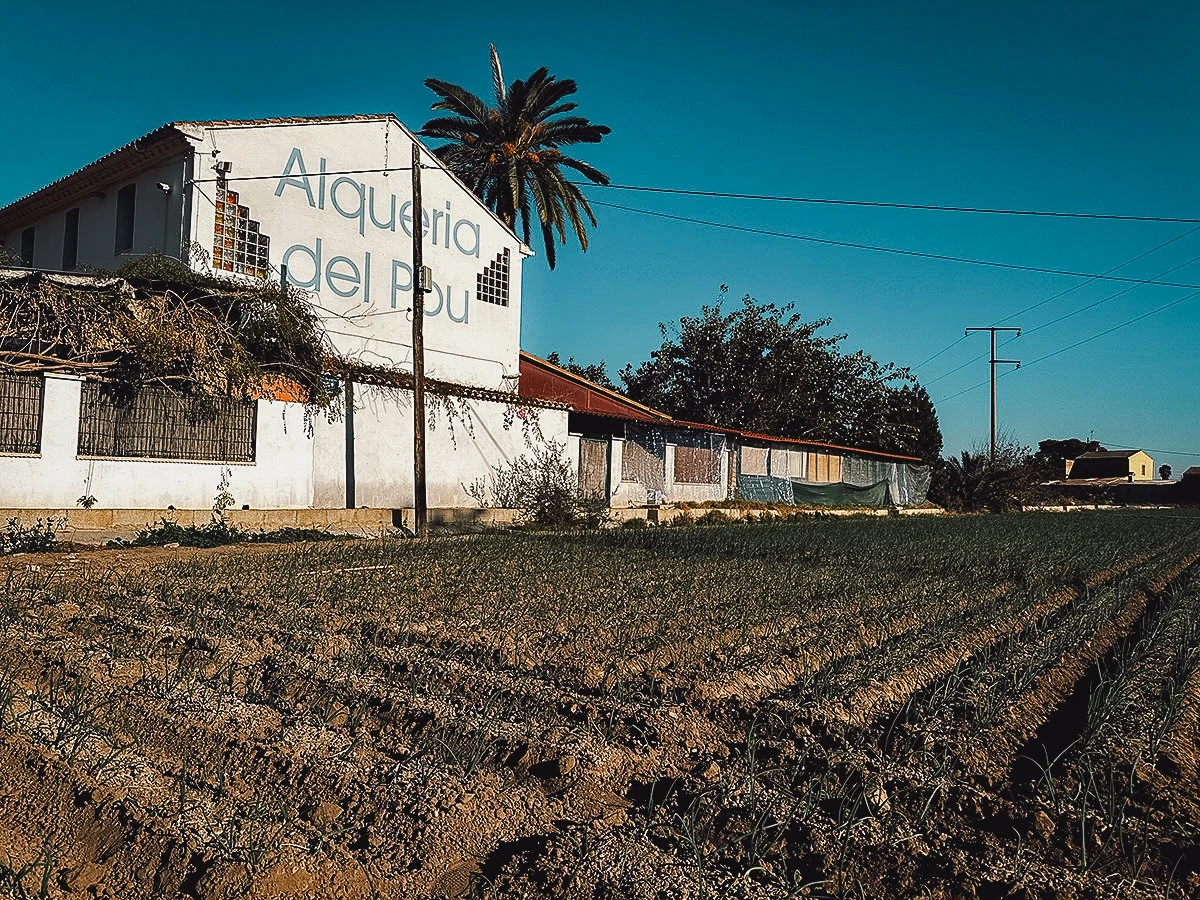
We’d never seen artichoke crops before so this was an unexpected treat. If you eat at Alqueria del Pou from November till March, then you’ll know that the artichokes on your plate were harvested directly from these fields.

We sat in this garden area but Alqueria del Pou is a large restaurant with indoor seating as well. It’s a gem and a great place to enjoy a meal before or after visiting Ciudad de las Artes y Ciencias.

Alqueria del Pou
Address: Entrada Rico, 6, Quatre Carreres, 46013 València, Valencia, Spain
Operating Hours: 1-5PM, Mon-Sat (closed Sundays)
6. Menjars la Barraca (Cheap but Delicious Valencian Paella!)
Needless to say, eating paella is something you need to do in Valencia. However, it isn’t the cheapest dish. A paella in Valencia will run you anywhere between EUR 30-60 for two people at any restaurant worth its weight in saffron. Thankfully, there are places like Menjars la Barraca.
Located in El Cabanyal, about a 10-minute walk from the beach, Menjars la Barraca is a small takeaway shop run by a gentleman and his two adult sons. It’s a neighborhood favorite that offers takeaway tubs of paella valenciana, fideua de marisco, arroz al horno, and other dishes starting at just EUR 4 per order (January 2024).
Pictured in the foreground below is the shop’s specialty – paella valenciana. In the words of one regular:
“La mejor paella valenciana para llevar de la zona (y seguramente de más zonas en comparativa), espectacular.” (The best takeaway Valencian paella in the area (and surely in most areas in comparison), spectacular.)
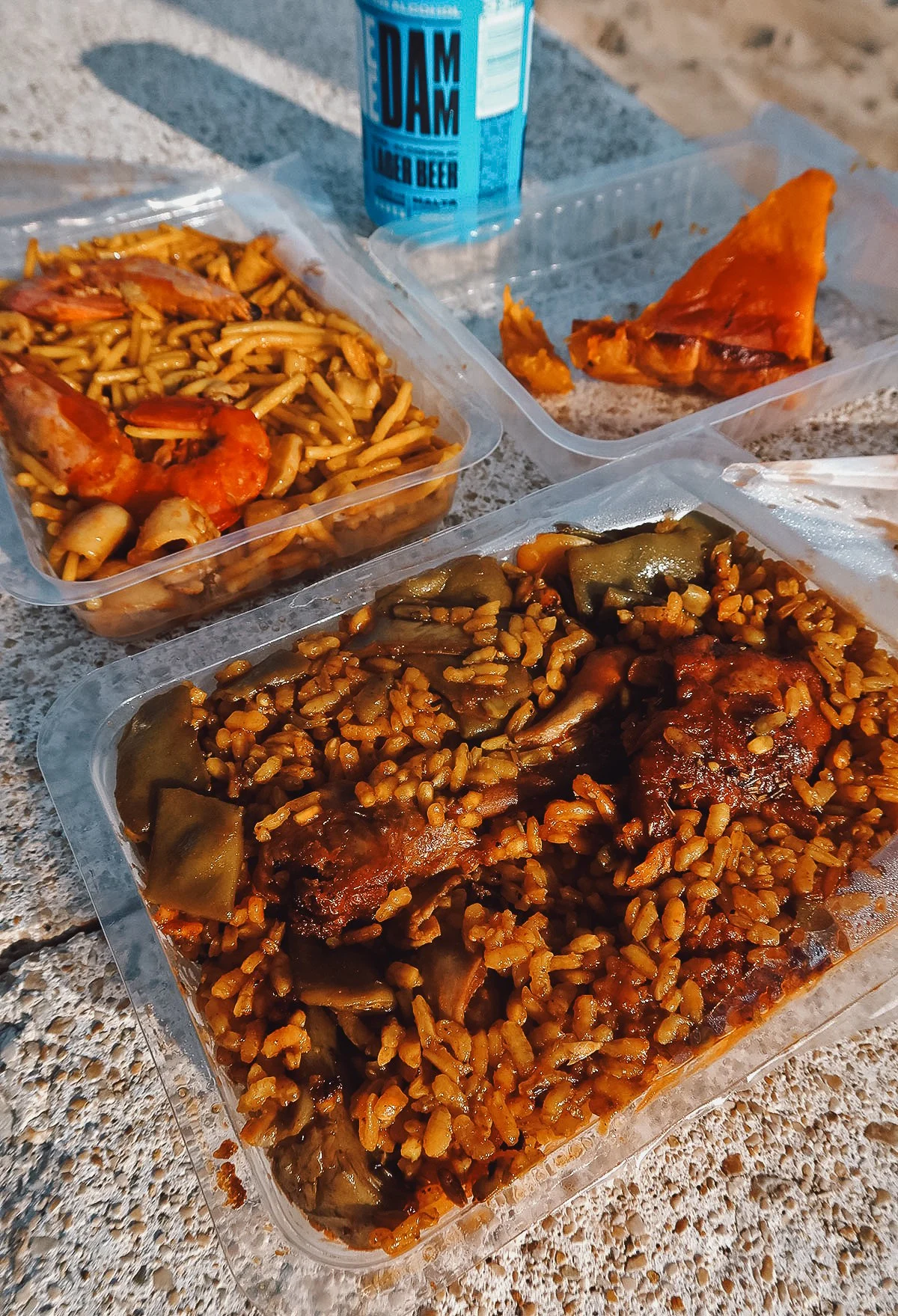
This is the fideua de marisco. Made with whole prawns and pieces of calamari, one takeaway tub set us back just EUR 4.50.
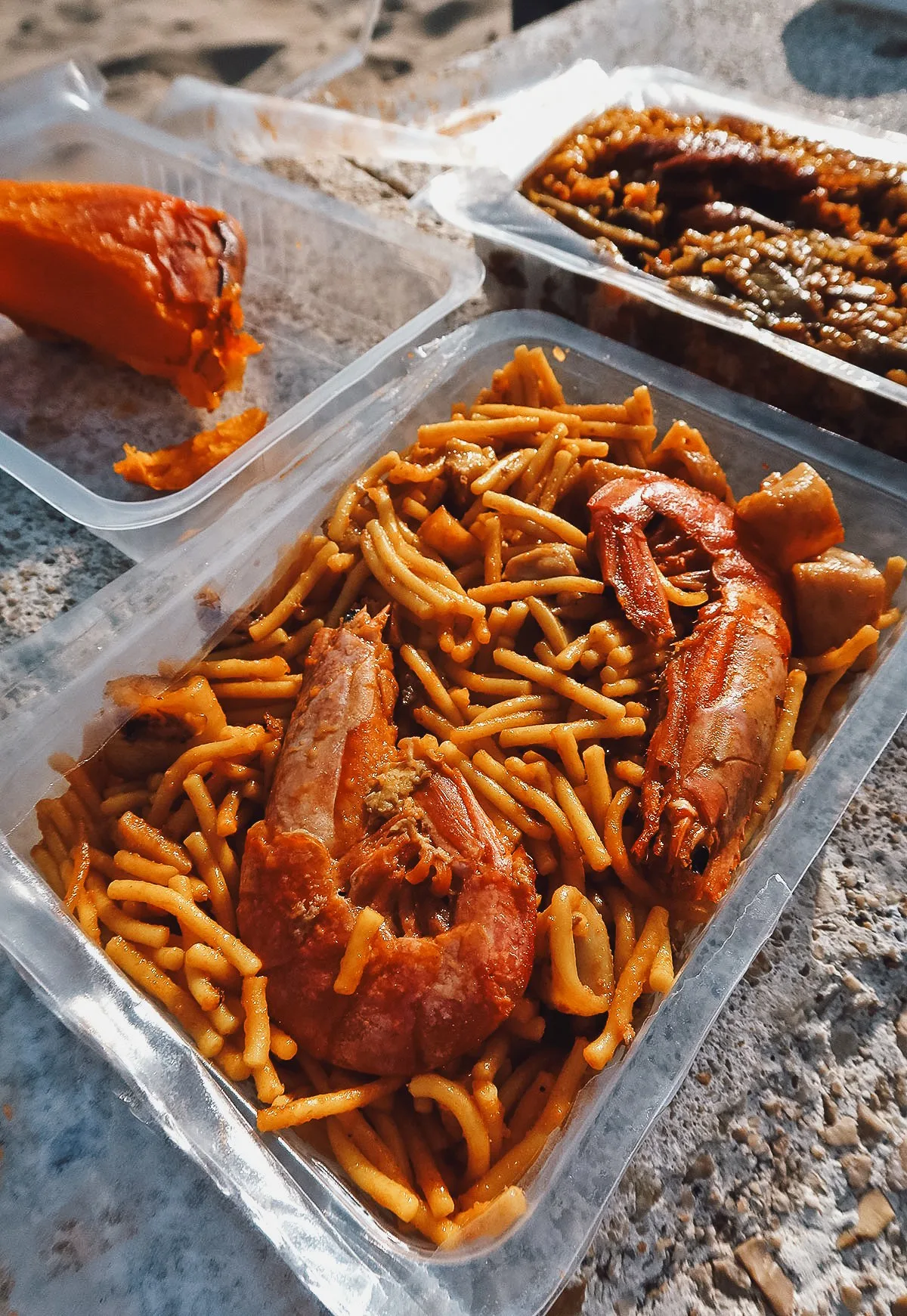
For dessert, we shared a simple but exceedingly delicious slice of calabaza asada or roast pumpkin.

You won’t find Menjars la Barraca on many “best paella in Valencia” lists but the locals in these parts know – this family-run restaurant really does serve some of the best paella in the area.
On our way out of the shop, one local told us: “They make really good paellas. You’ll love it.”
Indeed, we did!

Here’s a look inside the tiny shop. One son mans the front while his brother and father take care of the cooking and food preparation.
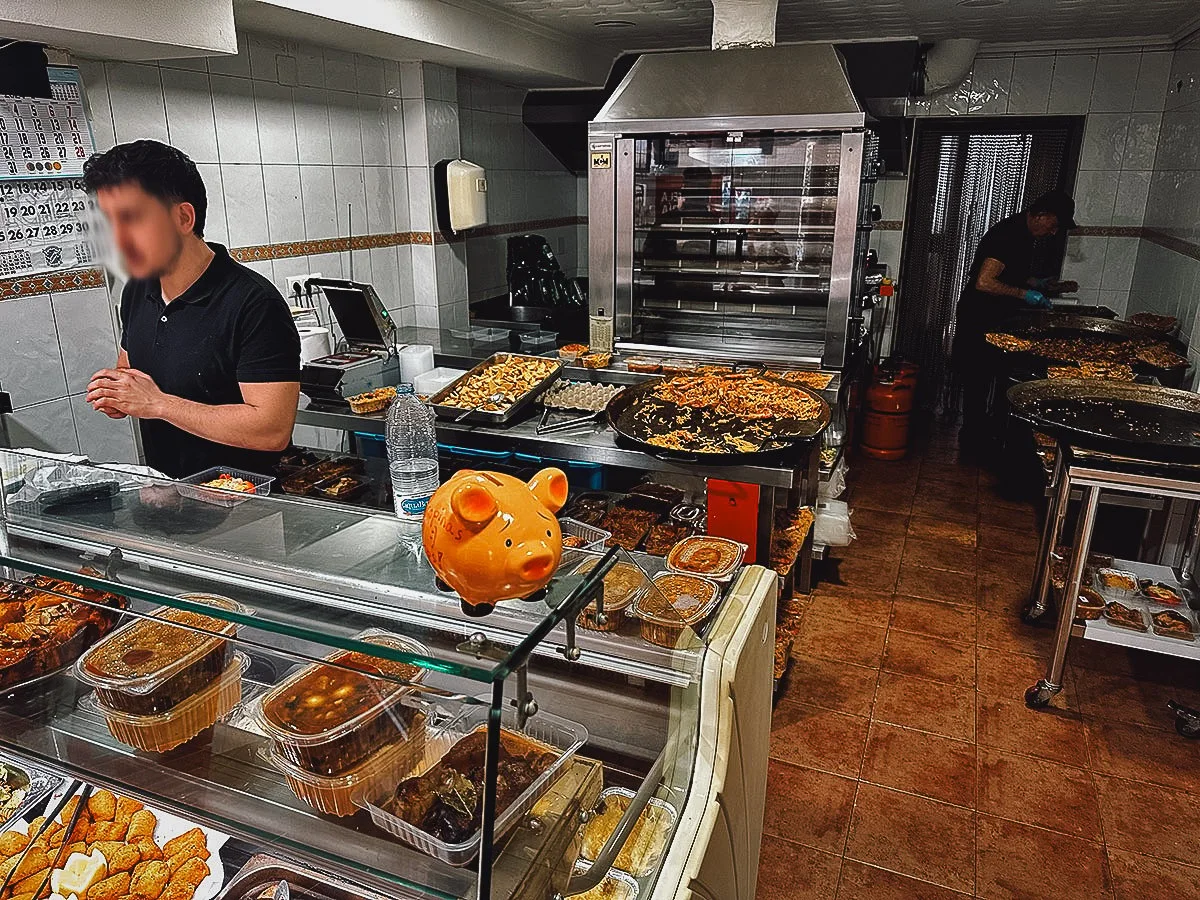
Based on their Google reviews, pretty much everything at Menjars la Barraca is delicious.
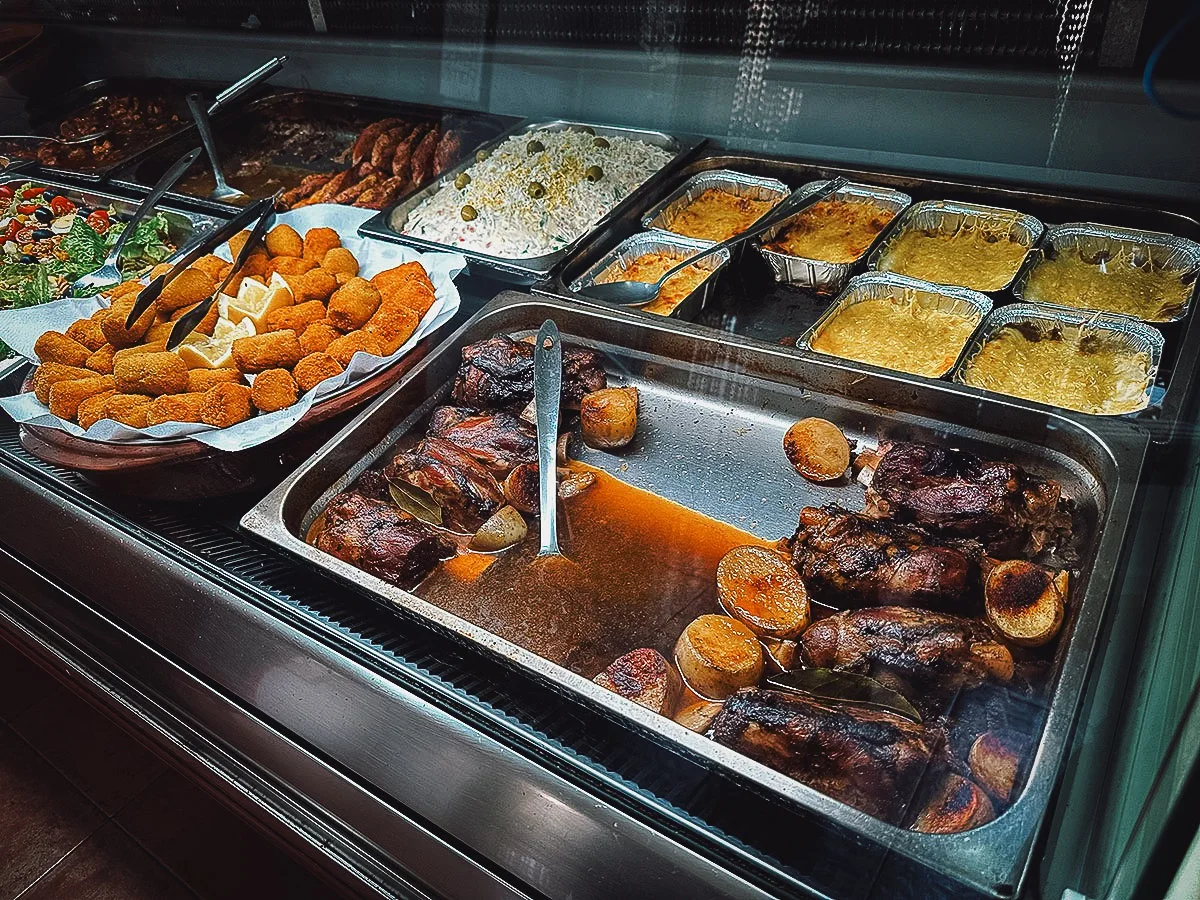
Menjars la Barraca may not be the fanciest restaurant on this list, but where else can you get delicious paella this cheap and eat it by the beach? No restaurant in Valencia can top this view!
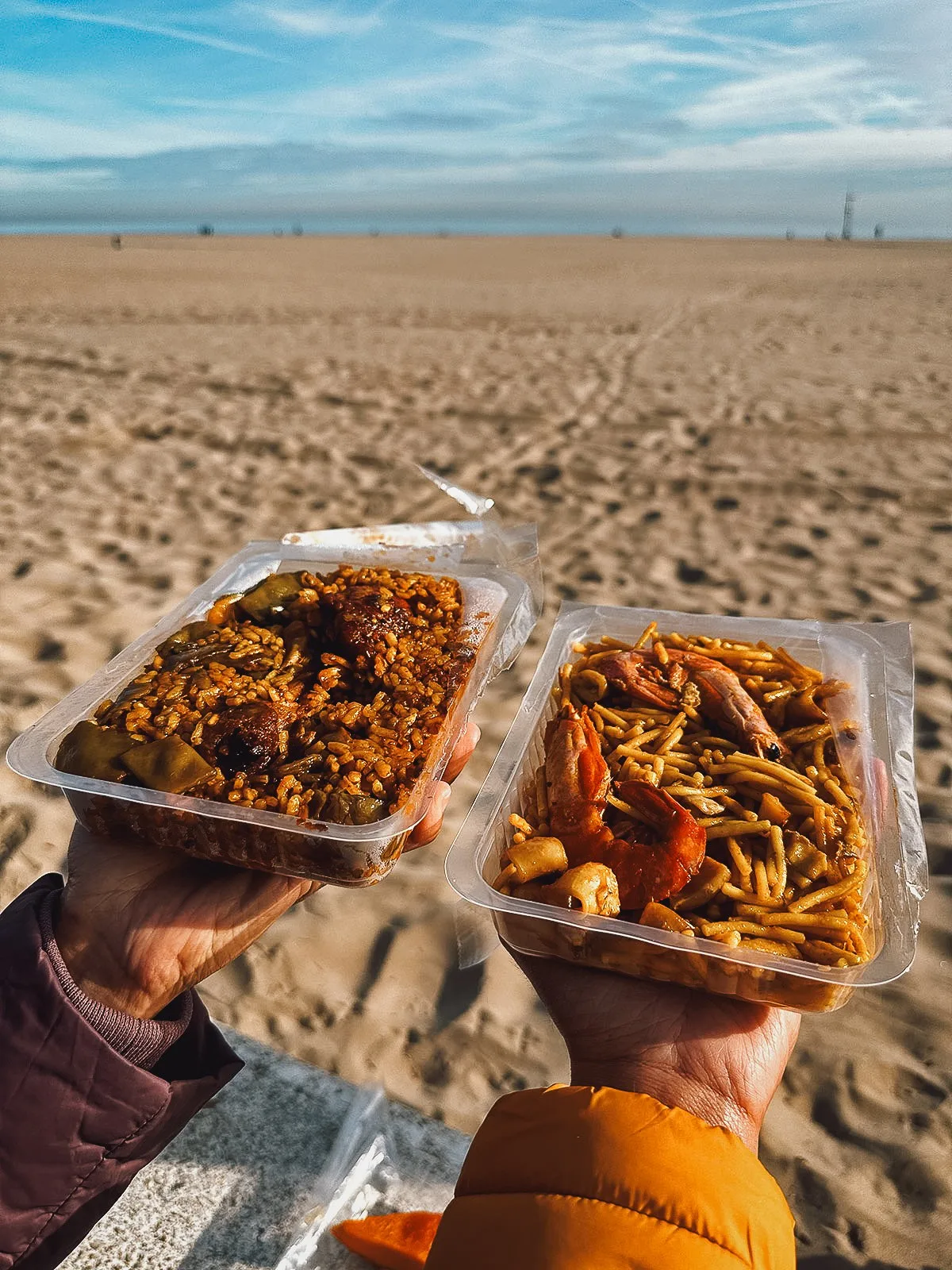
Menjars la Barraca
Address: C/ de la Barraca, 72, Poblats Marítims, 46011 València, Valencia, Spain
Operating Hours: 11AM-3:55PM, Sun-Fri (closed Saturdays)
LOCATION MAP
To help you find these paella restaurants in Valencia, I’ve pinned them all on the map below. Click on the link for a live version of the map.
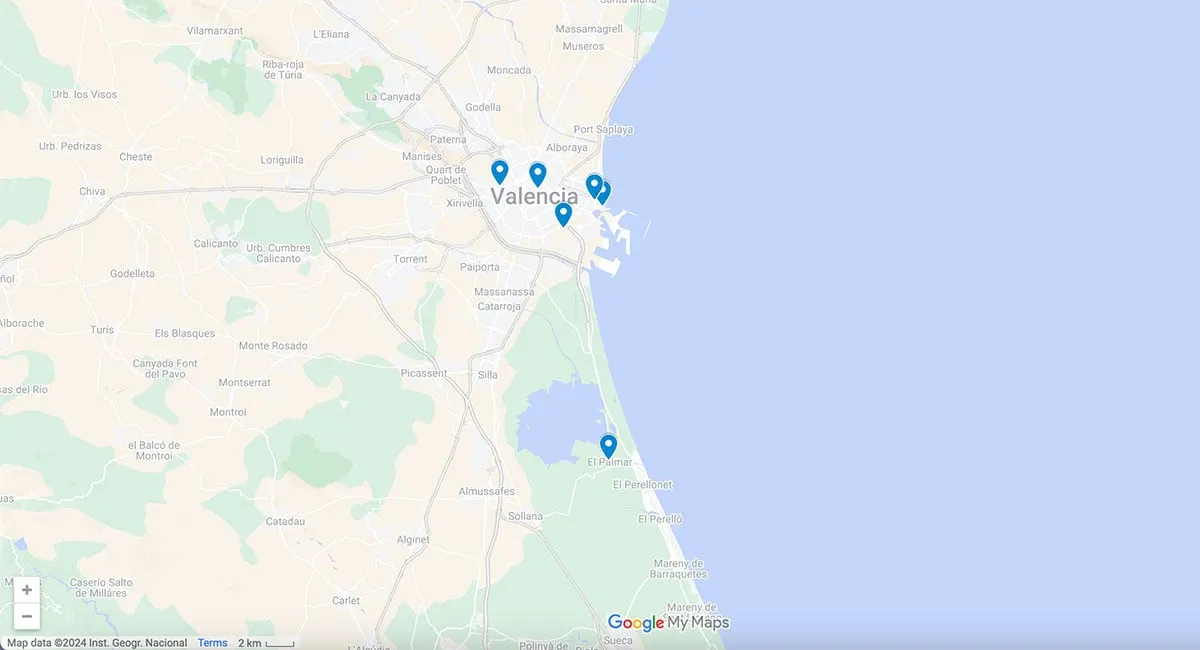
FINAL THOUGHTS ON THE BEST PAELLA IN VALENCIA
We had a satisfying paella experience in Valencia, but there was one notable restaurant that we couldn’t get to – Casa Carmela. Open since 1922, this family-run restaurant has been serving some of the city’s best paella for over a hundred years.
Unfortunately, Casa Carmela was closed for the holidays during our stay so we couldn’t go, but it’s the first restaurant we’ll visit on our next trip to Valencia. Casa Carmela is located near Malvarrosa Beach but if you’re looking for a good paella restaurant closer to the city center, then we’ve read that Casa Roberto is a good place to visit.
Thanks for reading and have the most amazing time eating paella in Valencia!
Disclosure
This article on the best paella in Valencia includes affiliate links, meaning we’ll earn a small commission if you make a booking at no additional cost to you. We appreciate your support as it helps us make more of these free travel and food guides. ¡Muchas gracias!

